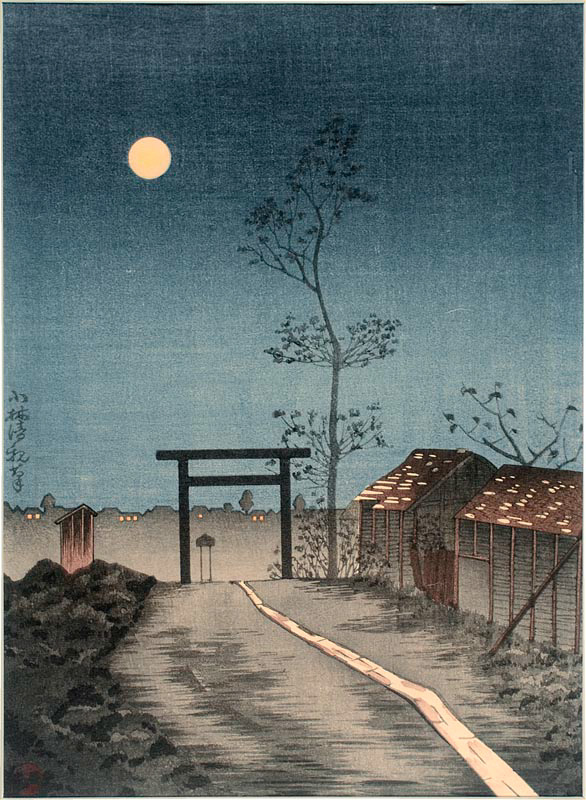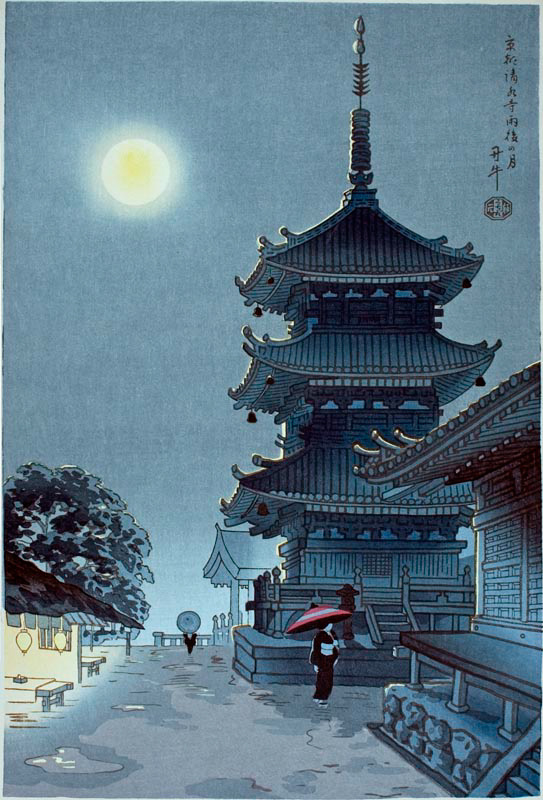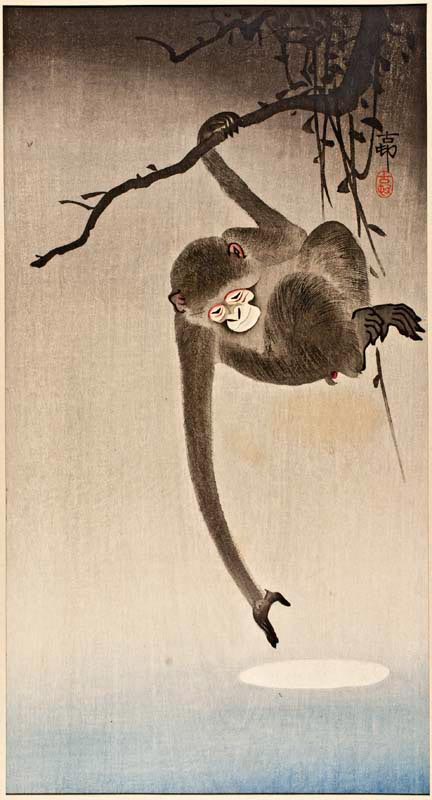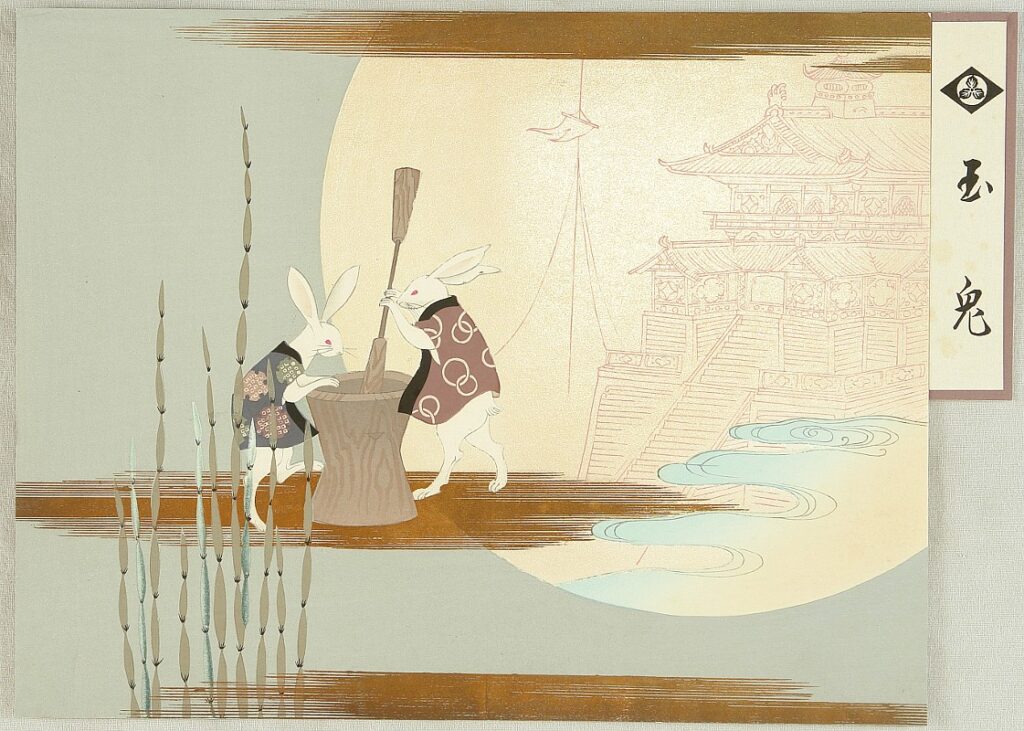by Alex Reyes
Overview
Historically, the sun is a prevalent characteristic of Japan. Called Nihon (日本) in the Japanese language, Japan being known as “the land of the rising sun,” the character “日” (pronounced “ni”) means “sun.” According to Shinto mythology, this strong correlation between the Japanese people and the sun is because the imperial family originated from Amaterasu, the sun goddess.
Thus, the sun becomes a strong, defining feature for Japan. The red circle on Japan’s flag is symbolic of the rising sun. During Japan’s imperial era, the flag at that time also featured a red, rising sun with expanding sun-rays. I wanted to explore what the opposite, essentially, of the sun was—the moon—in Japanese artwork. And so, the first part of the title, “日本、月本,” replaces the sun character (日) with the moon character (月, pronounced tsuki or getsu).
In exploring Japanese depictions of the moon, I decided that Japan-originating folktales revolving around the moon would make for a good focal point for the exhibition. Considering a lot of these folktales were intertwined with Buddhist and/or Shinto teachings, featuring woodcuts that also featured characteristics of those religions would also be beneficial. Coincidentally, moon imagery often coincides with autumnal imagery, prompting the idea of the harvest moon and otsukimi (the moon-viewing festival).
The exhibition will start off with two color woodcuts that pertain to Japanese shrine imagery. The first one is of a humble pathway to a shrine, the entryway to the Shinto shrine marked by the torii. The next color woodcut is that of a pagoda, which isn’t necessarily Japanese, and is typically associated more with Buddhism, which also isn’t inherently Japanese. However, this particular pagoda takes place at the Kiyomizu Temple, which is located within Kyoto—a city that was once Japan’s old capital, and thus known for having aspects of “traditional, pre-Meiji Japan.” Both of these color woodcuts are framed with the moon in the upper-left corner, and share the same palette of faded blues and other cool and/or muted colors. The moon is also in its full moon phase, suggesting the Buddhist concept of “enlightenment.”
The next three woodcuts regard Japanese folktales. The first folktale is a Buddhist tale in which a monkey, hanging from a branch, tries to reach for the moon, as the moon would (as aforementioned) be “enlightenment.” However, this monkey fails to realize that what it is reaching for is in fact a mere reflection of the moon, and thus falls into the water when the branch it is hanging onto breaks. This tale is a warning of disillusionment.
The next tale is about the moon rabbit, a tale commonly associated with otsukimi that occurs during the autumn. This tale, also in Buddhist origins, is about a rabbit that gave its life to feed a Buddhist deity that had been disguised as a weak, elderly man. Because this deity was touched by the rabbit’s selflessness, he put the image of the rabbit onto the moon, where it can be seen pounding rice into mochi, which are rice cakes, and are also commonly eaten during otsukimi.
The final woodcut is about a bamboo woodcutter who, one day, discovers a tiny girl in the shaft of a bamboo he had cut. As he raises this girl as his daughter, she grows into human size, and is regarded as more beautiful than any other human. Consequently, she receives suitors, but rejects all of them. On the fifteenth of the eighth month of the lunar calendar—the same day otsukimi takes place—she confesses to her father that she is, in fact, from the moon, and had been sent to Earth as a punishment. Tonight was when the Moon People would retrieve her. The Emperor, who had also sought to court the Moon Princess, was distraught when she returned to the moon. Thus, both the Emperor’s soldiers and the bamboo cutter guarded the dwelling of the Moon Princess so that the Moon People could not retrieve her. However, when the Moon People did arrive, they found themselves too stunned to attack, and watched as the Moon People donned the princess with a robe that made her forget about her life on Earth. Holding the letter he had written to her, the Emperor burns it atop Mount Fuji. That is the reason why it is said smoke can still be seen rising out of Mount Fuji.

Title: Pathway to a shrine
Artist: Kobayashi Kiyochika
Medium: color woodcut
Date: unknown
Dimensions: unknown
Description: A nighttime depiction of a pathway to a Shinto shrine, the entrance marked by the torii. The sparse trees, the dull, almost grey foliage, and the blue, muted color palette evokes feelings of quietness, coldness, and perhaps loneliness, as if the feeling of autumn or winter is coming. However, the distant houses with their windows lit up with a warm orange reminds the viewer that this place is not, in fact, lonely, and that there are still people around. The full moon situated in the upper-left corner symbolizes enlightenment in Buddhism, and is one of the brightest things in this woodcut, the second one being the pathway. The diagonal, right-to-left movement of the pathway guides the viewer’s eyes past the torii and into the sacred space of the not-depicted Shinto shrine, the brightness of the moon acting as the designated “ending point” for the viewer’s gaze to rest on. It evokes, then, a meditative state, as if the viewer themselves are the ones walking through this torii in order to seek enlightenment.

Title: Moon after rain, Kiyomizudera Temple, Kyoto
Artist: Asada Benji
Medium: color woodcut
Date: 1950s
Dimensions: unknown
Description: A moonlit view of a pagoda, which is located at the Kiyomizu Temple in Kyoto, the place of Japan’s previous capital. The pagoda, along with the rest of the buildings, are illuminated by the light of the full moon, which again, suggests the Buddhist idea of the full moon symbolizing enlightenment. The fact that the Japanese word kiyomizu translates to pure water, combined with the fact that this woodcut’s scene depicts this place post-rain, evokes the idea of “cleansing” or “purification.” The woman’s red umbrella also sparks attention, the red color, contrasted with the saturated blues and soft yellows, causing the viewer to also gaze upon this woman. Perhaps she is the “main character” of this woodcut, on her way to practice her religion.

Title: Monkey Reaching for the Moon
Artist: Kosan Ohara
Medium: color woodcut
Date: c. 1910
Dimensions: 14.6 in. x 9.8 in.
Description: Hanging from a bending branch, a monkey uses its free hand to reach for the reflection of the moon on the surface of the water. The moon is full, symbolizing enlightenment—however, the monkey reaching for the reflection of the moon, the false moon, suggests disillusionment. The only clear background details is the blue at the bottom of the print, which fades into the background, suggesting perspective, and the black branch connected to, imaginably, the rest of the tree. There also appears to be a guiding line within this woodcut. The black branch—whose saturation outweighs the pale blue at the bottom of the page—guides the viewer’s gaze to the monkey, the prevalent figure within this artwork, whose arm then guides the viewer’s gaze down to the moon’s reflection. This could arguably be seen as a contrast to Pathway to a shrine, as this time, the guideline flows downwards as opposed to upwards, fitting in line with the monkey’s disillusionment.

Title: Moon Rabbit
Artist: Gyokuho Kojima
Medium: woodblock print
Date: 1932-33
Dimensions: 12.2 in. x 9.5 in.
Description: Two white rabbits are presumably pounding rice into mochi whilst at the Moon Palace whilst dressed in kimono, most likely to prepare for otsukimi. The geography of the scene seems to be rather abstract, alluding to the divine nature of the Moon Palace—it is unclear where the rabbits are standing. The goldish-brown platform they are standing on may be a cloud, appearing that color rather than white to portray the opulence of the palace. Within the full moon, however, there is also a wispy object in the moon’s lower-right corner, its light line-art and pale white/blue colors seemingly more fitting for cloud imagery. So, what then, are the rabbits standing on? Moreover, the Moon Palace can be seen within the moon, its distance further marked by the light line-art and lack of fill color. On the lefthand side are strings of oval-shaped grains—since the rabbits are making mochi, perhaps this is a way of depicting the grains of rice that are about to be pounded?

Title: Tale of the Bamboo Cutter
Artist: Chikanobu Yoshu
Medium: woodcuts; ink on paper
Date: 1891
Dimensions: 14.6 in. x 9.8 in.
Description: With a grand plume of clouds streaming from the bottom-right to upper-left corners, the Moon Princess (the figure on the left) and a person from the moon who had come to retrieve her (the figure on the right) are depicted in the center of the print. The full moon, though slightly obscured from the clouds, is still prominent, a reminder of the Moon Princess’s original dwelling. Wrapped in a sakura-pink robe, symbolizing her fleeting time on Earth much like the fleeting blooms of sakura (cherry) blossoms, she and her attendant are presumably heading back to the moon. The bottom-left corner features a mountain, which may be Mount Fuji, a prominent symbol of Japan, and also where the Emperor had gone to burn the letter.
Bibliography
Images
- Asada Benji, Japanese, 1899-1984. Moon after rain, Kiyomizudera Temple, Kyoto, Kiyomizudera ugo no tsuki. 1950s. Artstor, library.artstor.org/asset/CONNASIAN_106310617196 (Access to Artstor required).
- Gyokuho Kojima, Japanese, 1907-1934. One Hundred Songs Illustrated – Uta-e Hyakuban – Kiyomoto Tama Usagi – Moon Rabbit. 1932-1933. Artelino, https://www.artelino.com/archive/ukiyoe_archive_show.asp?act=go&art=3234&ope=items&sea=&pp=1&rp=3.
- Kobayashi Kiyochika, Japanese, 1847-1915. Pathway to a shrine. Artstor, library.artstor.org/asset/CONNASIAN_106310617240.
- SHOSAN [Koson], Japanese. Monkey Reaching for the Moon. c.1910. Artstor, library.artstor.org/asset/CONNASIAN_106310617018.
- Yoshu Chikanobu, Japanese. Tale of the Bamboo Cutter, Fugaku Shu: Taketori Monogatari, Mt. Fuji Collection. 1891. Artstor, library.artstor.org/asset/AWILLIAMSONIG_10313361554.
Texts
- Ozaki, Yei Theodora. “The Bamboo Cutter and the Moon Child.” Japanese Fairy Tales. Lit2Go Edition. 1908. Web. <https://etc.usf.edu/lit2go/72/japanese-fairy-tales/4836/the-bamboo-cutter-and-the-moon-child/>. December 08, 2021.
- “Kiyomizudera Temple.” Kiyomizu-dera Temple. Web. http://www.kiyomizudera.or.jp/en/.
- “Monkey Reaching for the Moon’s Reflection (Toki Tōbun 土岐洞文), 1998-313,” Princeton University Art Museums collections online, December 8, 2021, https://artmuseum.princeton.edu/collections/objects/36448.
- “What is Otsukimi?”. Crow Museum of Asian Art. 2017. Web. https://crowcollection.org/education/otsukimi-moon-viewing-festival/.